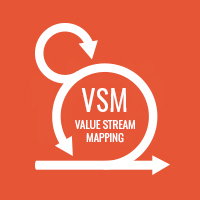Value stream mapping (VSM) is a lean management technique used to visualize and analyze the flow of materials, information, and activities required to deliver a product or service. The origin of VSM can be traced back to a technique of visual mapping the Toyota Motor Corporation used to understand the material and information flow within the organization. It is commonly used in manufacturing, but can also be applied to software development to identify and eliminate waste, or non-value-added activities, in the software development process.
VSM in software development involves mapping the end-to-end software development process, from initial concept to final delivery, including all the activities, steps, and handoffs involved in the process. The purpose of VSM in software development is to visualize the flow of work and to identify areas where waste may be occurring.
Waste in software development can take many forms, such as delays, rework, handoffs, redundant activities, and unnecessary documentation (See our January article: The Eight Wastes of Lean). VSM can help identify these wastes and their root causes so that appropriate measures can be taken to reduce or eliminate them.
Here are some ways in which VSM can help reduce waste in software development:
- Visualizing the process: VSM provides a visual representation of the entire software development process, allowing teams to see the flow of work and identify bottlenecks, delays, and redundant activities that may be causing waste.
- Identifying handoffs and delays: VSM helps identify handoffs between different teams or individuals. By visualizing these handoffs, teams can identify opportunities to streamline the process and reduce waste.
- Analyzing cycle time: VSM allows teams to measure the cycle time, or the time it takes for a work item to move through the entire development process. Analyzing cycle time can help identify areas where work items are getting stuck or delayed, and take actions to reduce these delays and streamline the process.
- Identifying rework and defects: VSM can help identify areas where rework and defects are occurring in the software development process. Visualization of these areas allows teams to address the root causes of rework and defects and reduce waste caused by rework.
- Streamlining the process: Once waste areas have been identified using VSM, teams can take measures to streamline the software development process by eliminating redundant activities, improving handoffs, optimizing cycle time, or addressing other identified areas of waste.
Building a Value Stream Map
Building a Value Stream Map requires collaboration among team members involved in the software development process and a willingness to challenge existing practices to identify areas of waste and improvement opportunities. It is an iterative process that requires continuous monitoring and improvement to achieve sustainable results. Here’s an overview of the process:
- Define the Scope: Determine the boundaries of the value stream you want to map. This could be a specific software development process, such as requirements gathering, design, development, change in data model, testing, or deployment, or the entire end-to-end software development process.
- Identify the Value Stream: Identify all the activities, steps, and stages involved in the software development process within the defined scope. This could include activities such as creating user stories, coding, testing, reviewing, and deploying software.
- Map the Current State: Create a visual representation of the current state of the value stream. This typically involves using a flowchart or a diagram to map out the sequence of activities and their interactions. Include information such as work-in-progress (WIP) inventory, cycle time, and handoffs between different teams or individuals.
- Collect Data: Collect relevant data about the software development process, such as cycle times, lead times, wait times, and defect rates. This data can help you identify areas of waste and opportunities for improvement.
- Analyze the Current State: Analyze the current state value stream map to identify areas where waste may be occurring, such as delays, rework, handoffs, or redundant activities. Use the collected data to identify performance metrics and areas that need improvement.
- Identify Opportunities for Improvement: Brainstorm with your team to identify potential opportunities for improvement. Look for ways to eliminate or reduce waste, streamline the process, and improve overall efficiency and effectiveness.
- Design the Future State: Create a new visual representation of the desired future state of the value stream. This should reflect the improvements identified in the previous step, and may involve changes such as process redesign, automation, or re-allocation of resources.
- Implement Improvement Actions: Develop an action plan to implement the identified improvement opportunities and move towards the future state. Assign responsibilities, set timelines, and track progress to ensure that improvement actions are executed effectively.
- Continuously Improve: Use the value stream map as a visual management tool to continuously monitor the software development process, track performance metrics, and identify further opportunities for improvement. Regularly update the value stream map as changes are implemented and improvements are realized.

